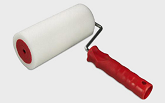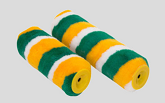Which Paint Rollers to Use?
Dec. 15, 2021It's not unreasonable to ask questions about which paint rollers and brushes to use, but many people are reluctant to ask us in person! Here's our short guide to help you choose the right roller for your job. Depending on the size of your job and the quality/type of the paint you choose, there are choices for rollers…many of them! We have simplified the choice with an overview based on surface type, paint type and, to some extent “user type”.
Rollers to use with most emulsion and masonry paints
Most emulsions are water based and require a smooth finish usually because they are being applied to a completely flat and even surface. Nobody wants to work hard at a painting task and then sit and stare at bits, bubbles or mottles. Here are the types of roller to consider for use with emulsion.
Woven Acrylic Roller
The Tiger Stripe roller! So called, we guess because of its tiger-like yellow with black stripe. These rollers are among our most popular with those in the trade. Acrylic is a versatile and reliable choice for both emulsion and masonry paints. This woven acrylic roller gives great performance at reasonable cost and is suitable for use with a wide range of paint types. The short pile makes it ideal for a smooth or semi smooth surface.
Same roller with a red stripe…this is the same woven acrylic as the tiger stripe but with the red stripe instead of black. The long pile makes it better for semi-rough/rough emulsion and masonry. A good blend of performance and price.
Heavy duty woven acrylic – Woven acrylic like the tiger stripes but heavy duty for rough and very rough surfaces.
Sheepskin Rollers
Sheepskin is an old/traditional trade favourite. Sheepskin is great for durability and washability so is excellent if you’re the type to spend time cleaning and re-using equipment. The sheepskin roller we supply is merino wool (finest grade sheepskin). Users love this for its good loading and release qualities, making it easy and quick to paint with.
Look for a medium pile for a matt finish or for use on a smooth or semi smooth surface. For semi smooth/masonry surfaces choose long pile.
Simulated mohair rollers
Simulated mohair can sometimes be a good choice for emulsion, the short-pile being best suited for applying a silk finish and for very smooth, flat surfaces. Mohair/simulated mohair tends to be better suited to gloss paints and while it can be used on artex and textured wall it is not always suitable for masonry paints and rough surfaces.
Microfibre rollers
Microfibre rollers give a smooth surface finish, with thick and even coverage – they are a good choice for emulsions. Microfibre loads paint better than some fabrics and has fine uniform release without any orange peel effects. It's a good choice if you're unsure, as it can be used with many different paint types.
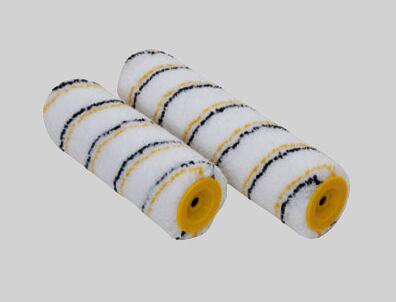
Polyamide and Polyester rollers
Polyester is a hard wearing fabric and has a dense fibre structure – ideally suited for all emulsions. This is an economical short term roller. Polyamide is tough fabric and is engineered to be durable so has longer product life than many other rollers with good paint pick up and release. Easy to clean and ideal for high quality paints.
Rollers to use with gloss and satin paints
Gloss/satin paints and varnishes have a different, more viscous texture and finish, so applying by roller can be a bit more unpredictable. Those in the trade tend to the know the application tricks and are adept at ‘laying off’ where necessary. We will post some painting tips in future blogs. Here are the rollers that can be used for gloss, satin, matt oils and varnishes etc.
Solvent Resistant Rollers
Solvent resistant rollers with the blue stripe! These nylon fabric rollers are extremely popular because of their superb solvent resistant properties. Use with solvent based paints, varnishes and two pack epoxy paints. We sell more of this type of roller than any other for use with our solvent-based paints and varnishes. The mini rollers in particular are ideal, sold in packs of ten and popular for smaller areas like door/window frames, line-detailing on boats and machinery etc. A solvent resistant floor painting roller kit is also available.
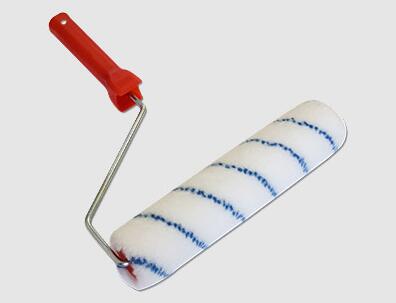
Foam rollers
Low density foam rollers are an economical option that do not shed pile or mottle easily. They are good choice for DIYers who want to use and dispose of equipment after a project. With solvent based paints, low density foam rollers don’t always last well and can ‘fall apart’ during use; we recommend the solvent resistant blue stripe version in preference to foam. High density foam rollers are trade quality and have the same qualities as the low density foam but are more durable and are popular with trade. Most of our trade customers avoid foam for solvent based paints but this option can be useful on occasion and for water based glosses etc.
Gloss pile simulated mohair/mohair rollers
Gloss pile simulated mohair/mohair rollers are popular with trade for water based glosses, satins and wood stains; be sure to choose gloss pile rather than longer pile which is better for semi smooth textured surfaces. Mohair (simulated) has good durability and tends not to shed.
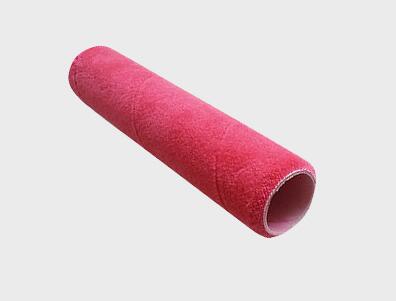
Other Paint Roller Tips
Here are some other tips to consider when purchasing a roller sleeve. As you have probably gathered from the above descriptions, as a rule (but not necessarily a hard an fast one), the shorter pile is generally preferred for smooth surfaces, while longer pile is better suited to rougher surfaces like artex, textured wallpapers etc. Extra long pile is usually the best choice for rough masonry. Foam is great for some purposes and is a good option for the DIYer who may want to dispose of equipment after a painting task. Choose high density foam for more durability.
✴The most common diameter of a standard roller frame is 1.75 inches
✴The most commonly used roller frame is the cage frame which has a single arm for the roller sleeve to push onto. Cage frames usually have a screw fit or taper fit on the handle to allow for extension pole attachment
✴A double arm roller frame is good for additional stability as it attaches to each side of the roller
✴Stick fit frames are good for quick, cheap tasks but do not always hold a large roller securely
✴Mini roller frames are usually stick fit for use with push on rollers of 4″ or 6″
✴A mini roller on a longer handle is great for hard to reach areas (like the back of a radiator)
Have a browse of all our rollers, frames, poles and kits here.









